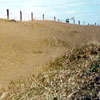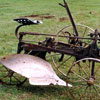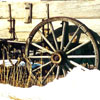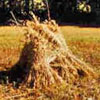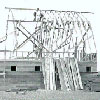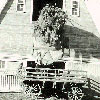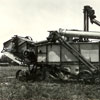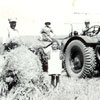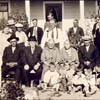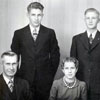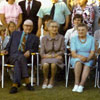Siim Erdman
After his mother's death, Siim walked as a ten year old child to Crimea and was raised by his Aunt Madly (Erdmann) Sesler who also raised Jacob Erdman after his parents died. It seems that Otto was a harsh taskmaster and made the Erdman boys work for seven years to pay back for the costs of their upbringing. Siim returned to Estonia where he married Pauline Roos, who was about 20, when he was probably in his early 30's.
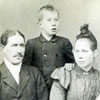 Siim Erdman 1851-1936
Siim Erdman 1851-1936
First Cousin of Jacob Erdman of Barons.
Married: Pauline Natalia Roos (1863-1934) in Estonia.
Parents: Hans Erdmann and wife Madli (Estonia)
Arrived in Barons from Estonia in 1910.
Children:
- Gustav Johannes (1887-1963) (G.J or "Big Gus", m. Linda Jurman, 1924)
- Helene (1890-1910 - died of typhoid at age 20)
- Alide (1895 - 1982) (m. Gus Kulpas - double wedding with G.J, 1924)
When Siim was 59, his cousin Jacob Erdman wrote to him from Barons, Alberta, and described the wonderful farming opportunities in Alberta, so Siim and his family sailed for the "New World" in 1910. A few months after their arrival their 20 year old daughter Helene died of typhoid. His son Gus (Big Gus) Erdman was 23 by this time. Since his second cousin (son of Jacob Erdman) was also named Gus, was only 5' 7'' while G.J. was 6' 4" they became known locally as Little Gus and Big Gus.
At this time there were about 26 Estonian/Crimean families totaling about 77 people living in Barons. Ten families came from Crimea via Dakota, 9 families came directly from Crimea and 7 came directly from Estonia.
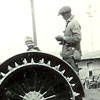 At first the Siim Erdman family stayed with the Jacob Erdmans until they purchased the SE quarter of 6-12 23 where they lived in a homesteader shack until they purchased the NE quarter of31-12-23 and built a house there. The house was followed by the construction of a large horse barn the same year. In 1924 Gustav married Linda Jurman and Alide married Gus Kulpas in a double wedding ceremony. Shortly after this Gus and Linda moved to her uncle Martin Silberman's farm and sold the original quarter to Gus and Alide Kulpas.
At first the Siim Erdman family stayed with the Jacob Erdmans until they purchased the SE quarter of 6-12 23 where they lived in a homesteader shack until they purchased the NE quarter of31-12-23 and built a house there. The house was followed by the construction of a large horse barn the same year. In 1924 Gustav married Linda Jurman and Alide married Gus Kulpas in a double wedding ceremony. Shortly after this Gus and Linda moved to her uncle Martin Silberman's farm and sold the original quarter to Gus and Alide Kulpas.
In 1931 Gustav J and Linda purchased their own land the SW quarter of 5-12 23, just diagonally across the corner from Alide and Gus Kulpus Siim lived with Gustav and his family until his death until 1936 while Pauline stayed with Alide and Gus Kulpas until her death in 1934.
Gus Kulpas (1886-1977 age 91)
Born: 1886 in Crimea
Arrived in Barons from Crimea via South Dakota in 1905 with his father and older brother John. His cousin Anton Kulpas also lived in Barons with his wife Miina (Erdman) and family.
Homesteaded east of Barons, but sold that land.
Married: Alide Erdman, (1895-1982) daughter of Siim, in 1924, sister of G.J.
Settled on land near G.J. Erdman South West of Barons
One daughter: Dorothy (1925-1964)
Gus, his father and brother, all homesteaded in the Barons area. John Kulpas sold his land to Mr. Kotkas and moved with his wife Julie Reinstein to Montana in 1910. Gus's father died that same winter in Barons.
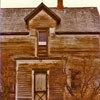 Gus stayed around Barons. About that time, he and his cousin, Anton Kulpas, bought a gasoline engine threshing machine and later a steam engine machine and which they operated for ten years. When Anton Kulpas moved to Oregon with his wife Miina and family, they sold the thresher. Gus then took a short course at the Calgary Technical School, in the early 1920's when he was 34. When he was 38 he married Alide Erdman, in 1924. The Kulpas house had been built in 1918. Gus farmed there until he and Alide retired to Lethbridge in 1970. Their daughter Dorothy married Dick Haddlington and lived in Lethbridge where she died in 1964 at the age of 39 from asthma.
Gus stayed around Barons. About that time, he and his cousin, Anton Kulpas, bought a gasoline engine threshing machine and later a steam engine machine and which they operated for ten years. When Anton Kulpas moved to Oregon with his wife Miina and family, they sold the thresher. Gus then took a short course at the Calgary Technical School, in the early 1920's when he was 34. When he was 38 he married Alide Erdman, in 1924. The Kulpas house had been built in 1918. Gus farmed there until he and Alide retired to Lethbridge in 1970. Their daughter Dorothy married Dick Haddlington and lived in Lethbridge where she died in 1964 at the age of 39 from asthma.
Gustav Johannes (G.J., Gus, or Big Gus) Erdman
Born: Estonia in 1887
Died in Barons 1963 at age 76.
Married in Barons in 1924, to Linda Jurman who was born in Poltsamaa, Estonia in 1894.
She died in Calgary in 1979 (age 85).
Her parents were Hans and Malle (Silberman) Jurman of Estonia.
Gus's Parents: Siim and Pauline (Roos) Erdman of Estonia.
Three Children: all born in Barons on the Silberman farm.
- Karl Lembit, 1926
- Ilmar Ernst, 1927
- Aino Evelyn, 1930
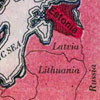 Fourteen years after he arrived in the Barons area with his parents, brother and sisters, Gus married Linda Jurman. Linda was accompanied by her uncle Martin Silberman in 1921 on the trip from Estonia when she was 27. She worked for her uncle for two years on the farm and then married GJ.
Fourteen years after he arrived in the Barons area with his parents, brother and sisters, Gus married Linda Jurman. Linda was accompanied by her uncle Martin Silberman in 1921 on the trip from Estonia when she was 27. She worked for her uncle for two years on the farm and then married GJ.
G.J. and Linda farmed the Silberman farm south of Barons while the Silbermans were in Estonia until 1931. Their three children were born on that farm. Linda's love of flowers was evident there, and later at their own farm about 3 miles west which they purchased from Mr. Alexander. (This was the original Cochrane homestead.)
Linda's flowers became famous in the district. Thousands of blooms decorated the farmyard in every corner. Water from the irrigation canal was hauled in a "water wagon" on Sunday's by Gus, who often made the trip four or five times each Sunday first with the horses pulling the wagon and later by tractor. The huge vegetable garden fed the family all winter.
In the early 1920's though, the very dry climate was a hardship, and Linda had to take the horse and buggy into the village to buy a few groceries for the family.
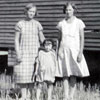 A cook house was essential for the threshing crew. Cooks were hired to feed the men, sometimes numbering 20 or more. These houses were pulled out into the field like chuck wagons. They were moved from field to field as the work progressed.
A cook house was essential for the threshing crew. Cooks were hired to feed the men, sometimes numbering 20 or more. These houses were pulled out into the field like chuck wagons. They were moved from field to field as the work progressed.
When farming became mechanized, the harvest crews were reduced to only one or two hired men, so the cook houses were left on the farmyard and recycled as chicken coops, or living quarters for the hired man.
The construction of the farm buildings was a huge job. There was a "lumber yard" in the village where farmers could purchase materials. Neighbours would help to build the barn. This is G.J.'s barn being built in 1918. The horses and cows would be fed and sheltered here, especially in winter.
This complicated piece of farm machinery was called a separator. Bundles of wheat were fed into it. The grain was funnelled into wagons for delivery to the elevators in the village. The straw was blown into a large straw stack which was used for feeding and bedding the livestock in the winter time. In the 1930's these separators were replaced by combines, which were first pulled by tractors, Later "self-propelled" combines were invented. Often farmers did work for their neighbours who did not invest in a "separator".
The straw was used on the floor for warmth and when it became filled with manure it was pitched outside onto the manure pile, which was valuable as fertilizer for the gardens after it had "cured" for about three years.
Vegetables and flowers were grown in abundance on most of the farms in the area. Fruit trees were rare, with crabapples and some small plums surviving the dry climate and cold winters which reached minus 35 C with heavy drifting snow, before the climate change made six foot tall snowbanks a thing of the past.
The farmers bought sugar, tea, coffee, salt, apples in season, but meat and vegetables were usually home grown and butter and milk were provided by the herd of cattle. Chickens were grown on every farm, so eggs were abundant and Sunday roast chicken was common. When cattle or pigs were slaughtered many farmers made "head cheese" (jellied meat), sausage and bacon. Fish was available at Keho Lake and some farmers had smoke houses to smoke the fish.
Linda and Gus were very active in the Estonian community in Barons. Birthdays were celebrated at various farms throughout the area. Food was brought by all guests. After the meal the men would gather for "refreshments" and conversation while the women drank their tea and got caught up on the local news in the other room or another part of the garden. A group photo was usually taken on these occasions.
Christmas was a "12 day celebration". From the day after Christmas to a few days after New Years, Estonians would circle from home to home throughout the season. Some of the older Estonians learned very little English as their social life was exclusively centered on the Estonian community in Barons and Lethbridge.
Linda was a devoted gardener in summer and in the winter she did needlework and other handiwork. Many of her fancy table cloths and bedspreads are owned by her children and grandchildren.
After WWII, Linda and G.J. "sponsored" the families of three members of Linda's sister Ida's family. They left Estonia during the war, often walking from farm to farm. They had lived in refugee camps in Europe until the paper work could allow them to emigrate. They lived on G.J.'s farm for one or more years until they found work in other places in Lethbridge, Calgary and Toronto. The farm house was a busy place at that time.
Gus was an active member of the United Grain Growers and of the local school board.
He passed away in Barons in 1963 at the age of 75. Linda survived him by 16 years. When she left the farm, Linda lived with Evelyn in Calgary.
Gus's children all graduated from the University of Alberta, Karl in physics, Ilmar in Agriculture, and Evelyn in Home Economics. (Just a note about U of A. A certain chemistry professor was known to remember Barons students. If someone from Barons showed up in his class, he would inform his new class that for decades, students from place called Barons would pop up in his class and soon be getting top marks...so watch out...He referred to Oscar, Ralph, G.J.'s three children and many more Barons students at U of A as the years went bye).
Karl took postgraduate work at UBC and received his PhD in physics there. He became well-known in nuclear physics, at UBC and an internationally. He married Dorothy Helgerson and they have three daughters: Linda, Ann and Barbara.
Ilmar received his Masters in bacteriology and worked for the Food and Drug Directorate at the federal government in Ottawa. He and his wife Lorna (Dixon) have four sons: John, Eric, Neil and Mark.
Evelyn worked for Canadian Western Natural Gas in the "Blue Flame Kitchen" in Calgary for 34 years. She wrote food articles for the Calgary Herald ,often appeared on "Wild Rose Forum" on CBC radio, as well as on local TV cooking shows.
Evelyn and her mother made a trip back to Estonia to visit their relatives in 1966. In 1975 Linda went again to Estonia by herself, 54 years after the young Linda Jurman sailed to America with her uncle, Martin Silberman.
In 1996, Evelyn married David Rimmer, who had also worked with Canadian Western Natural Gas for many decades. They had 10 happy years together. He passed away in his mid '80's in 2006. Evelyn has lived in her house in southwest Calgary since 1963.
The G.J. Erdman family farm near Barons is still in the family after nearly 90 years. John Erdman, Ilmar's son, (married and living in Red Water,) manages the farming business for his grandparents' family.
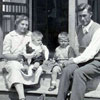 1929 - G.J. , Linda and their sons Ilmar and Karl at the Silberman farm 3 miles south of Barons. A butter churn is behind them. They lived here for about 7 years during the 1920's and early 1930's
1929 - G.J. , Linda and their sons Ilmar and Karl at the Silberman farm 3 miles south of Barons. A butter churn is behind them. They lived here for about 7 years during the 1920's and early 1930's
The horse harness shed is in the background behind the grain wagon. Household water was hauled from the irrigation lake one mile away. Cattle drank the alkaline water from the well, pumped by a windmill north of the house.
Linda started her interest in gardening at this farm which was about 3 miles from where they eventually lived for over 30 years. Linda retired to Calgary after her husband passed away. She died in 1979, age 85.
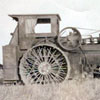 Steam provided the power for the engine that separated the grain from the straw which was blown into 8 metre tall stacks used during the winter for livestock food and barn floor covering to absorb manure.
Steam provided the power for the engine that separated the grain from the straw which was blown into 8 metre tall stacks used during the winter for livestock food and barn floor covering to absorb manure.
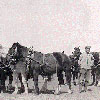 Horses brought the bundles from the fields to the separator. The bundles were piled into a "hayrick". Pitching bundles was not for those with a weak back. Harvest crews sometimes numbered 25 men plus hired cooks. The cook cars were pulled into the fields for the convenience of feeding the men at the work site.
Horses brought the bundles from the fields to the separator. The bundles were piled into a "hayrick". Pitching bundles was not for those with a weak back. Harvest crews sometimes numbered 25 men plus hired cooks. The cook cars were pulled into the fields for the convenience of feeding the men at the work site.
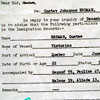 A document regarding G.J.'s arrival in 1910. He sailed on the "Victorian" to Quebec at the age of 22 and took the train to Lethbridge from there. He was inquiring about his landed immigrant records when applying for the "old age security", in 1957.
A document regarding G.J.'s arrival in 1910. He sailed on the "Victorian" to Quebec at the age of 22 and took the train to Lethbridge from there. He was inquiring about his landed immigrant records when applying for the "old age security", in 1957.
This is a typical Estonian gathering, in this case for Ellen Erdman Johnson's birthday in 1939 held at her brother Victor's home (the original Jacob Erdman house.)
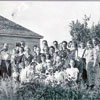 In the picture are the Andreksons, (George, Sally and their four children) Oscar Erdman,Gus Erdman and his wife Magda, Jaan and Helena Kotkas August and Alma Hebenik, Alex Hebenik and his wife, Julia Kananen, Lisa Silberman, the Pertels, the Gus Kulpases, Linda and G.J. Erdman and their children,( Evelyn, Karl and Ilmar), Ellen and Roy Johnson and family: (Barbara, Gerald, Lawrence).
In the picture are the Andreksons, (George, Sally and their four children) Oscar Erdman,Gus Erdman and his wife Magda, Jaan and Helena Kotkas August and Alma Hebenik, Alex Hebenik and his wife, Julia Kananen, Lisa Silberman, the Pertels, the Gus Kulpases, Linda and G.J. Erdman and their children,( Evelyn, Karl and Ilmar), Ellen and Roy Johnson and family: (Barbara, Gerald, Lawrence).
The school has four rooms on the main floor and four rooms upstairs. In the basement some exercise sessions substituted for phys ed classes in winter. Basketball games were part of the program. Students walked to the Community Hall three blocks away until the gym was built in years later. Baseball was popular too. Later curling and skating rinks were built by the Hall.
In 2006 the school is being rented out to a drama society. It is not used as a school because of the lack of school age students in the community.
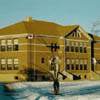 This is the Barons Consolidated School which was built in 1930 and closed its doors to students about 70 years later. Over several generations, many students of Estonian heritage took 12 years of schooling here and many went on to University and other forms of higher education. School buses, first pulled by horses, and later motorized yellow buses drove in all four directions, sometimes over an hour one-way, to collect the children from the farms. When roads were snowed in students had a holiday. Tom Peacocke at the telephone office notified the farmers if the buses were going out or staying at the garage in the village due to bad weather. The school population reached 160 during its peak. Sports teams often won Southern Alberta competitions in basketball and baseball. Spring drama productions, Christmas concerts, Sports Day in May and graduation dances in June were some of the highlights of the school year.
This is the Barons Consolidated School which was built in 1930 and closed its doors to students about 70 years later. Over several generations, many students of Estonian heritage took 12 years of schooling here and many went on to University and other forms of higher education. School buses, first pulled by horses, and later motorized yellow buses drove in all four directions, sometimes over an hour one-way, to collect the children from the farms. When roads were snowed in students had a holiday. Tom Peacocke at the telephone office notified the farmers if the buses were going out or staying at the garage in the village due to bad weather. The school population reached 160 during its peak. Sports teams often won Southern Alberta competitions in basketball and baseball. Spring drama productions, Christmas concerts, Sports Day in May and graduation dances in June were some of the highlights of the school year.
Once a month the school sponsored a dance such as the Sadie Hawkins Dance (a hillbilly costume dance) at the community hall. The whole community attended. There was a lunch break half way through the dance. Sometimes live music by local groups provided the music. The churches, the school and the sports organizations provided a lively social life for the village.
During the cold months the mothers in the village cooked hot soup for all of the students who stayed in the school over the lunch hour. Home Economics and Shop were taught for many years. Typewriting, drama, art, singing, and French were part of the curriculum. Every spring the high school presented a three-act play in the community hall. Most of the community came to enjoy the event.
Some of the teachers remained on staff for over 40 years, teaching several generations over the years. They were usually strict and efficient, and students were encouraged to be resourceful and hard working. All of Linda and GJ's children went to the University of Alberta after passing the government grade 12 exams at this school with excellent marks.
The transition from grade 8 to grade 9 was marked by a dress-up day of pranks and snake dances through the town, even through the pool hall! This was called "initiation". These were the days when students made their own fun, before TV and video games.
About 1,000 former students and teachers attended the 75th anniversary of the Consolidated School District in 1991 to celebrate the occasion of bringing in the students from the one-room schools that dotted the district to the two room brick school which stood where the community hall stands now The "big school" with 8 rooms and two storeys was 61 years old at the time of the 1991 reunion. That weekend was one to remember when many generations of former students gathered in the village.
Siim passed away in 1936, age 85 and Pauline died in 1934, age 74. They are buried together with daughter Helena in the Barons Cemetery which was originally owned by Estonian pioneers and later given to the village of Barons. It was recently tidied up before the Centennial Celebrations, 2004.

